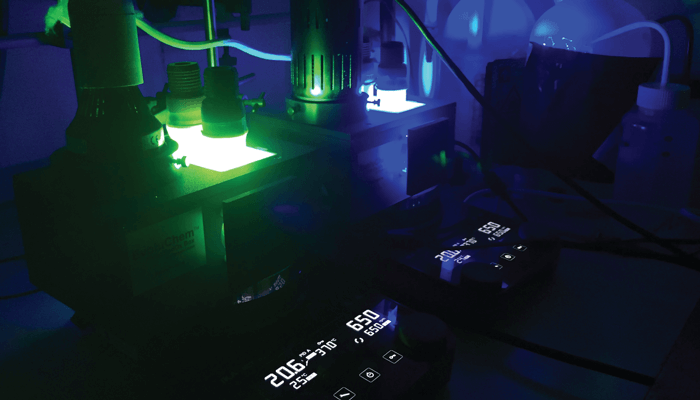Chemistry researchers from the UK’s University of Bath have developed a method for drug production that could help reduce energy consumption, chemical waste, and carbon emissions in the pharma industry.
The technique uses 420 nanometer blue light and a photocatalyst to facilitate chemical reactions that produce nitrogen-containing chemicals called primary amines, which are used in more than half of all pharmaceutical drugs. The blue light method requires less energy and fewer steps than traditional drug production, which is estimated to produce waste and drugs at a ratio of 100:1. Much of this waste material is then incinerated, contributing to CO2 emission figures that a recent study calculated to be higher than those of the automotive industry.
Lead scientist Alex Cresswell explains the new technique: “Once the photocatalyst has absorbed the light energy, it becomes reactive enough to tear away an electron from one of our reactants. This produces an entity called a “radical,” – a molecule bearing an odd number of electrons. We harness the reactivity of that radical to achieve unusual reactions.”
As a test, Cresswell’s team used the blue light method to synthesize the multiple sclerosis drug Fingolimod, and were able to reduce the process from five to two steps. The drug is produced and sold by Novartis under the name Gilenya (with sales of US$3 billion in 2020).
The team is currently working alongside industry partners to further develop and commercialize the blue light technique. Cresswell is optimistic that medicinal chemists will adopt the method, but notes that scaling up presents technical challenges: “Light-mediated reactions are hard to scale up to the multi-kilogram or tonne scale, because the light doesn’t penetrate very deeply into the reaction mixture. Flow chemistry offers the best solution to this – it would involve pumping the mixture through transparent tubing wrapped around a powerful light source. We’ve already shown that our reaction can be scaled up to decagrams in this way.”






